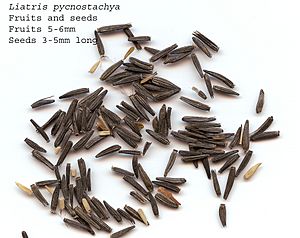Prairie blazing star facts for kids
Quick facts for kids Prairie blazing star |
|
|---|---|
 |
|
| Scientific classification |
The Liatris pycnostachya, also known as the prairie blazing star or cattail blazing star, is a beautiful plant. It is a perennial plant, which means it lives for more than two years. This plant naturally grows in the tallgrass prairies found in the central United States.
What it Looks Like
The prairie blazing star has tall flower stalks. These stalks usually grow to be about 60 to 120 centimeters (2 to 4 feet) tall. Sometimes, they can even reach up to 180 centimeters (6 feet) high!
Its leaves are long and thin, much like grass. They are about 11 to 22 centimeters (4 to 8.5 inches) long and 4 to 10 millimeters (0.15 to 0.4 inches) wide. These leaves grow from the plant's root and also in large numbers along the flower stems. The leaves get smaller as you look higher up the stem.
The top of the flower stem has a spike covered in many small flower heads. Each flower head is about 6 to 12 millimeters (0.25 to 0.5 inches) across. They bloom in late summer, from the top of the spike downwards, for about a month. The flowers are usually pink to purplish-pink.
Each flower head has 5 to 8 tiny flowers called florets. Around these florets are overlapping pinkish leaf-like parts called bracts. The tips of these bracts are pointed and curve backwards. This special shape helps tell the prairie blazing star apart from other similar Liatris plants. For example, the Liatris spicata also has thick spikes, but its bracts are flat with rounded tips. The stems, leaves, and bracts of the prairie blazing star can be smooth or a bit hairy.
Its Roots
The prairie blazing star has a special root system. It grows from a round, solid underground stem called a corm. Sometimes, this corm can also grow into a rhizome, which is another type of underground stem that spreads horizontally. The plant produces new shoots from its root system, slowly forming a larger clump over time.
Why the Name?
The scientific name pycnostachya comes from Ancient Greek words. The word pycnos means "dense," and stachys means "ear of grain." This name describes the plant's flowers, which are packed very closely together on the spike, looking like a dense ear of grain.
Home for Moths
The prairie blazing star is an important plant for some insects. It acts as a host plant for the bleeding flower moth (Schinia sanguinea). This means that the caterpillars of this moth eat the plant's leaves and flowers as they grow.


